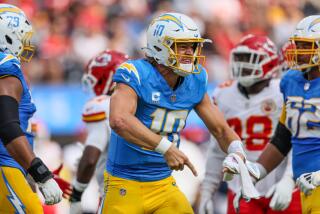Members Won’t Work at Stadium for Football Games : Unions Agree to Honor Chargers’ Picket Lines
- Share via
In a show of solidarity, representatives of four unions whose members make up the bulk of the 1,600-person work force at San Diego Jack Murphy Stadium said Friday that their members will not cross picket lines set up by striking San Diego Chargers football players.
Union officials said they also will urge all their members--not just those who work at the stadium--and anyone else who is a union member to boycott any game that is played with scabs, as NFL owners have threatened to do.
The effect of the unions’ position, however, won’t be felt for several weeks because, with the cancellation of this Sunday’s home game against Seattle, the Chargers’ next home game is Oct. 25.
By then, the strike could be settled or the games played by scabs may amount to such a failure in the eyes of fans that the contests would be scuttled.
The City of San Diego, which will lose $187,000 Sunday when the stadium remains empty, and stadium officials say it’s too early to indicate how they would react to a union boycott on Oct. 25. “We’ll learn from the experience of other stadiums during the next three weeks,” said Steve Shushan, the stadium’s business manager. “We’ll just have to see.”
Union leaders said Friday they support the strike by the players because the issues in the labor dispute are similar to those facing all labor unions.
“They are much the same issues that shape the bargaining agenda of unions throughout this country,” said Joseph S. Francis, executive secretary-treasurer of the San Diego-Imperial Counties Central Labor Council. “Among other things, they involve worker rights, fair treatment on the job, a fair share of revenues and the right to bargain and speak out without reprisal.
“The NFL players acutely feel the need to preserve the fundamental trade union principle--the very concept of a team--that no single player can advance unless all advance,” said Francis, speaking from a prepared text.
Owners Criticized
“Owners of NFL teams,” he said, “have demonstrated that they are no different from other employers, and they have shown that they are just as ready to resort to union-busting tactics as any factory owner.”
The unions represented at Friday’s news conference included Service Employees International Union, Local 102, which represents many of the people who clean the stadium; Local 481 of the Teamsters Union, whose members include parking lot ticket takers and those who make deliveries at the stadium; Hotel Employees & Restaurant Employees Union, Local 30, which represents the largest chunk of workers--the roughly 1,000 who work in concessions and as ushers--and Amalgamated Transit Union Local 1309, whose members drive San Diego Transit buses used to carry about 3,000 fans to each home game.
Workers at the stadium are paid hourly, ranging from bus drivers who make about $19.75 an hour on an overtime basis to those who work in concessions, earning about $6.50 an hour. The workers are employed by a variety of companies as well as the City of San Diego.
Joseph said that, although the salaries of Chargers players--a few of whom make nearly $47,000 each game--dwarf those of union members, the two groups share a common labor struggle. He pointed out, for example, that most NFL players--those whose identities and skills are lost amid the attention afforded the league’s superstars--have very short careers and need protection.
Wes Chandler, the Chargers’ player representative who plays wide receiver, and Gil Byrd, a defensive back, attended the press conference. Chandler said the unions’ support “means an awful lot to the players.”
While free agency has received the most attention as the key element behind the strike, Chandler said there are several other important issues such as an improved arbitration and grievance procedure, protection for union player representatives, guaranteed contracts for veteran players, and revisions in the players’ pension fund.
He noted, for example, that the average NFL career lasts 3 1/2 years. In contrast, he said, it takes a player four years to be vested in the league’s pension plan. Even then, Chandler said, a 10-year veteran can expect to receive about $800 to $900 a month at age 55.
By the 1990s, Chandler said, the NFL will become a $2-billion-a-year industry--money, he emphasized, that is generated by the players.
“People come to see the players,” Chandler said. “We are the game . . . and we’re asking for our fair share.”
Noting the celebrations this year in honor of the Constitution’s bicentennial, Chandler said, “We want our freedom.”
“For 67 years (since the NFL was founded) we’ve been denied the right to decide where we want to play,” he said.
More to Read
Go beyond the scoreboard
Get the latest on L.A.'s teams in the daily Sports Report newsletter.
You may occasionally receive promotional content from the Los Angeles Times.










